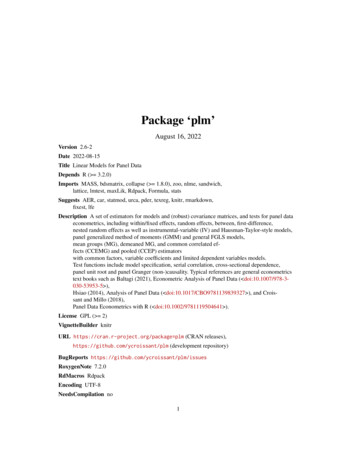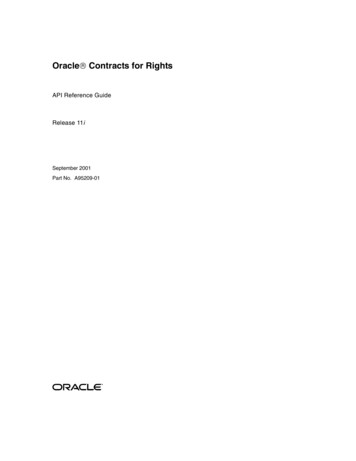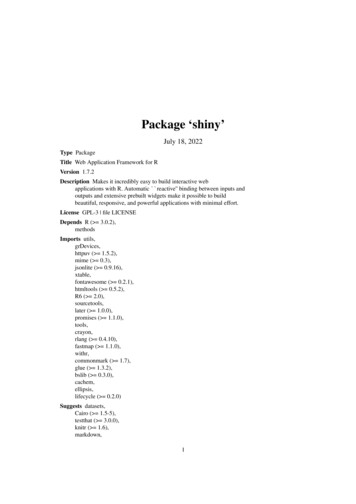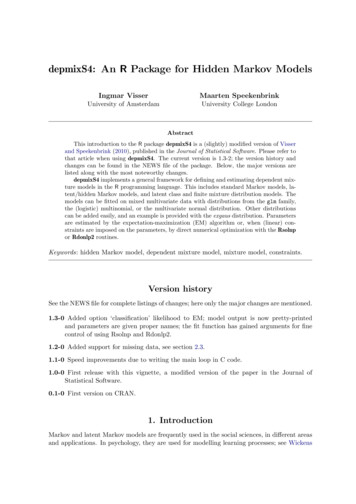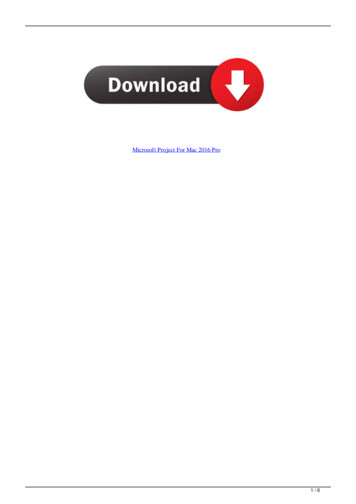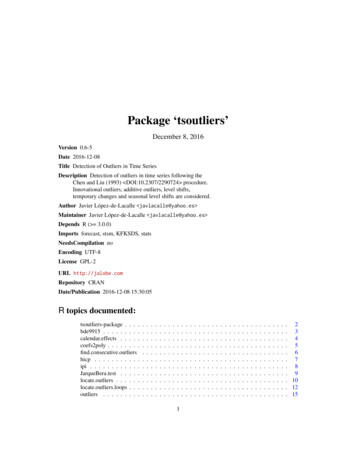
Transcription
Package ‘tsoutliers’December 8, 2016Version 0.6-5Date 2016-12-08Title Detection of Outliers in Time SeriesDescription Detection of outliers in time series following theChen and Liu (1993) DOI:10.2307/2290724 procedure.Innovational outliers, additive outliers, level shifts,temporary changes and seasonal level shifts are considered.Author Javier López-de-Lacalle javlacalle@yahoo.es Maintainer Javier López-de-Lacalle javlacalle@yahoo.es Depends R ( 3.0.0)Imports forecast, stsm, KFKSDS, statsNeedsCompilation noEncoding UTF-8License GPL-2URL http://jalobe.comRepository CRANDate/Publication 2016-12-08 15:30:05R topics documented:tsoutliers-package . . . .bde9915 . . . . . . . . .calendar.effects . . . . .coefs2poly . . . . . . . .find.consecutive.outliershicp . . . . . . . . . . .ipi . . . . . . . . . . . .JarqueBera.test . . . . .locate.outliers . . . . . .locate.outliers.loops . . .outliers . . . . . . . . .1. 2. 3. 4. 5. 6. 7. 8. 9. 10. 12. 15
2tsoutliers-packageoutliers.effects . liers . .print.tsoutliers . .remove.outliers .tso . . . . . . . .Indextsoutliers-package.1618192122232529Automatic Detection of Outliers in Time SeriesDescriptionThis package implements a procedure based on the approach described in Chen and Liu (1993) forautomatic detection of outliers in time series. Innovational outliers, additive outliers, level shifts,temporary changes and seasonal level shifts are considered.DetailsTime series data often undergo sudden changes that alter the dynamics of the data transitory orpermanently. These changes are typically non systematic and cannot be captured by standard timeseries models. That’s why they are known as exogenous or outlier effects. Detecting outliers isimportant because they have an impact on the selection of the model, the estimation of parametersand, consequently, on forecasts.Following the approach described in Chen & Liu (1993), an automatic procedure for detection ofoutliers in time series is implemented in the package tsoutliers. The procedure may in turn be runalong with the automatic ARIMA model selection strategy available in the package forecast.The function tso is the main interface for the automatic procedure. The functions locate.outliers.oloopand remove.outliers implement respectively the first and second stages of the procedure. In practice, the user may stick to use the function tso.Although the purpose of the package is to provide an automatic procedure, the implementationallows the user to do a manual inspection of each step of the procedure. Thus, the package is alsouseful to track the behaviour of the procedure and come up with ideas for possible improvementsor enhancements.The functions locate.outliers.oloop and remove.outliers implement the major steps of theprocedure. tso is the main interface to the automatic procedure. All the options at any stage of theprocedure can be defined through the arguments passed to tso. Despite the user may stick to usethe function tso, other functions called by this main interface are exported in the namespace of thepackage. They are helpful for debugging and allow the interested user to more easily track eachstep of the procedure.Information supplemental to these help pages is given in the document that is provided with thepackage (‘tsoutliers/inst/doc/tsoutliers.pdf’ in the source files).
bde99153Author(s)Javier López-de-Lacalle javlacalle@yahoo.es ReferencesChen, C. and Liu, Lon-Mu (1993). ‘Joint Estimation of Model Parameters and Outlier Effects inTime Series’. Journal of the American Statistical Association, 88(421), pp. 284-297. doi: 10.2307/2290724Gómez, V. and Maravall, A. (1996). Programs TRAMO and SEATS. Instructions for the user. Bancode España, Servicio de Estudios. Working paper number 9628. ch/dt9628e.pdfGómez, V. and Taguas, D. (1995). Detección y Corrección Automática de Outliers con TRAMO:Una Aplicación al IPC de Bienes Industriales no Energéticos. Ministerio de Economía y Hacienda.Document number D-95006. 20DE%20TRABAJO/D95006.pdfHyndman, R.J. and Khandakar, Y. (2008). ‘Automatic Time Series Forecasting: The forecast Package for R’. Journal of Statistical Software, 27(3), pp. 1-22. http://www.jstatsoft.org/v27/i03Hyndman, R.J. with contributions from George Athanasopoulos, Slava Razbash, Drew Schmidt,Zhenyu Zhou, Yousaf Khan, Christoph Bergmeir and Earo Wang (2014). ‘forecast: Forecastingfunctions for time series and linear models’. R package version 5.4. https://CRAN.R-project.org/package forecastbde9915Data Set: Working Paper ‘bde9915’DescriptionData set employed for illustration in the working paper referenced below.Usagebde9915FormatA list containing the following monthly series: gipi: Italian industrial production index (1981:1-1996:12); euprin: European price index of industrial production (1981:1-1993:1) (*); metipi: Spanish production index of metal products (1980:1-1997:7).(*) 1993:12 is reported in the reference document.NoteThe authors of the reference working paper probably use additional variables such as holidays toobtain the results reported in the document.
4calendar.effectsReferencesKaiser, R., and Maravall, A. (1999). Seasonal Outliers in Time Series. Banco de España, Serviciode Estudios. Working paper number 9915.calendar.effectsCalendar EffectsDescriptionThis function creates regressor variables for trading day, Easter and leap year effects over the sampleperiod where the input time series is sampled.Usagecalendar.effects(x, trading.day TRUE, easter 6,leap.year FALSE, holidays NULL, easter.date easter.datea monthly time series.logical. If TRUE, trading day regressor variable is returned.numeric. The number of days before Easter over which the Easter effect spans.If it is set to zero Easter variable is not returned.logical. If TRUE, leap year regressor variable is returned.an optional numeric vector of the same length as x containing the number ofholidays for each time period.logical indicating whether the date of Easter should be returned.DetailsLet wd be the number of working days in a given month and nwd the number of non-working days.The trading day variable at time t is built as follows:wd wd holidaysnwd nwd holidaystdt wd (5/2) nwdBy default, working days are the days from Monday to Friday and non-working days are Saturdaysand Sundays. If there are additional non-working days they can be defined in argument holidays.For example, if the 1st of February is a local holiday, the user can define a variable containing zerosfor all periods except for the periods related to February where the 1st of February falls withina working day (Monday to Friday); these data are set to one so that they are considered as nonworking days.Easter effect is defined as the proportion of days before Easter (by default easter 6) that lie inMarch and April, respectively for each month. It contains zeros for the remaining months.The leap year is a vector of zeros for all months except February, where the variable takes on thevalue 0.75 if the year is a leap year and 0.25 otherwise.
coefs2poly5ValueA mts matrix containing the selected calendar effects by columns.If easter.date is TRUE a list is returned containing the mts matrix of calendar effects as well asthe dates of Easter for each year of the sample.Examples# display calendar effects for a sample span period# no data are actually necessary in the input series# since calendar effects are concerned only with the dates# at which the data are sampledx - ts(frequency 12, start c(1980, 1), end c(2000, 12))ce - calendar.effects(x, leap.year TRUE)colnames(ce)plot(ce, main "calendar effects")# Easter days for each yearcalendar.effects(x, easter.date TRUE) eastercoefs2polyProduct of the Polynomials in an ARIMA ModelDescriptionThis function collapses the polynomials of an ARIMA model into two polynomials: the product ofthe autoregressive polynomials and the product of the moving average polynomials.Usagecoefs2poly(x, add TRUE)Argumentsxan object of class Arima, as returned by arima.addlogical. If TRUE, the polynomial of the differencing filter (if present in the model)is multiplied by the stationary autoregressive polynomial. Otherwise only thecoefficients of the product of the stationary polynomials is returned.ValueA list containing the elements: arcoefs, the coefficients of the product of the autoregressive polynomials; macoefs, the coefficients of the product of the moving average polynomials. This list is ofclass "ArimaPars" so that it can be recognized by outliers.tstatistics.
6find.consecutive.outliersExamples# ARIMA(0,1,1)(0,1,1) modelfit - arima(log(AirPassengers), order c(0,1,1),seasonal list(order c(0,1,1)))coefs - coef(fit)# "coefs2poly" returns the coefficients of the product of# the non-seasonal and the seasonal moving average polynomialsa1 - convolve(c(1, coefs[1]), rev(c(1, rep(0, 11), coefs[2])), type "open")[-1]a2 - coefs2poly(fit) macoefsa2all.equal(a1, a2, check.names FALSE)# since the model does not contain an autoregressive part# the product of the regular and the seasonal differencing# filter is returned if "add TRUE"coefs2poly(fit) arcoefs# an empty set is returned if "add FALSE"coefs2poly(fit, add FALSE) arcoefs# in a model with non-seasonal part and no differencing filter# no multiplication of polynomials are involved and# the coefficients are the same as those returned by "coef"fit - arima(log(AirPassengers), order outliersFind outliers at consecutive time pointsDescriptionFind outliers at consecutive time points and discard those with lower t-statistic in absolute value.Usagefind.consecutive.outliers(x, type)Argumentsxa data frame containing the type, index and t-statistic related to each outlier,named respectively by columns: type, ind and tstat.typea character, the type of outlier to be checked for runs at consecutive points.
hicp7DetailsIn the procedure, this function is applied by type of outliers, e.g., two or more consecutive LS arereduced to one LS. It is still possible to get two or more consecutive outliers of different type atconsecutive time points. Alternatively consecutive outliers of any type could be reduced to a singleoutlier, For the time being, this is kept in this way so that for example, the following sequence AO1,LS2, LS3,LS4 can collapse to AO-1,LS-4, i.e., the AO is kept.ValueThe row names of input x pointing to the outliers to be discarded, i.e., outliers with lower significance than adjacent outliers of the same type.NoteThis function is intended for internal use; no check is done for correctness of the arguments passedas input.hicpData Set: Harmonised Indices of Consumer PricesDescriptionHarmonised indices of consumer prices in the Euro area.UsagehicpFormatA list containing the following monthly indices (2005 RGY00.4.INXICP.M.U2.N.SERV00.4.INXAll the series end in December 2013.DescriptionOverall indexFood and non-alcoholic beveragesFoodMeatFishFruitVegetablesProcessed food incl. alcohol and tobaccoUnprocessed foodIndustrial goods excluding 995:11995:11995:11990:11990:11990:11990:11990:1
8ipiSourceEuropean Central Bank. Statistical Data Warehouse. http://sdw.ecb.europa.eu/.ipiData Set: Industrial Production IndicesDescriptionIndustrial production indices in the manufacturing sector of European Monetary Union countries.UsageipiFormatA list containing monthly indices (2010 100) for the following 999:1All the series end in December 2013.NoteData base key: “sts inpr m”, monthly short-term business statistics. Production in industry.Gross data for Ireland is not available in Eurosta’s data base, only seasonally or working day adjusted data are available for this country.SourceEUROSTAT. Statistical Office of the European Communities. http://ec.europa.eu/eurostat.
JarqueBera.testJarqueBera.test9Jarque-Bera Test for NormalityDescriptionThis function applies the test for normality proposed in Jarque and Bera (1980).UsageJarqueBera.test(x, fc 3.5, .)Argumentsxa time series of residuals or an object of class Arima.fca numeric. Factor to asses whether the first residual observations are to be omitted. Ignored if x is not an Arima object. See details.further arguments. Currently omitted.DetailsThis function is based on function jarque.bera.test available in package tseries. Here, theresults are split in a test for the null hypothesis that the skewness is 0, the null that the kurtosis is 3and the overall Jarque-Bera test.The input can be a time series of residuals, jarque.bera.test.default, or an Arima object,jarque.bera.test.Arima from which the residuals are extracted. In the former case the wholeinput series of residuals is used. In the latter case, the first n0 (defined below) residuals are omittedif they are are equal to zero or if any of them are in absolute value larger than fc times the standarddeviation of the remaining residuals. n0 is set equal to x arma[6] x arma[5] * x arma[7],i.e. the number of regular differences times the periodicity of the data times the number of seasonaldifferences. If n0 happens to be equal to 1 it is set to 2.If the latter trimming operation is not desired, the argument fc can be set to a high value to ensure thecomplete series of residuals in considered; or the function can be called as jarque.bera.test(residuals(x)).Missing observations are omitted.ValueA list containing one htest object for the null hypothesis that the kurtosis is 3, the skewness is 0and a test combining both the kurtosis and the skewness to test for the normality of the input data.ReferencesJarque, C. M. and Bera, A. K. (1980). ‘Efficient test for normality, homoscedasticity and serialindependence of residuals’. Economic Letters, 6(3), pp. 255-259.See Alsoprint.mhtest.
10locate.outliersExamples# fit an ARIMA model to the HICP 011600 series# ARIMA(0,1,0)(2,0,1) was chosen by forecast::auto.arima(ic "bic")# normality of the residuals is rejected at the 5% significance level# due to an excess of kurtosisdata("hicp")y - log(hicp[["011600"]])fit1 - arima(y, order c(0, 1, 0), seasonal list(order c(2, 0, (fit1))# fit ARIMA model for the same series including# detected by "tso" and for the model chosen by# normality of the residuals is not rejected at# after including the presence of outliersmo - outliers(c("AO", "AO", "LS", "LS"), c(79,xreg - outliers.effects(mo, length(y))fit2 - arima(y, order c(1, 1, 0), seasonal xreg xreg)JarqueBera.test(fit2)locate.outliersoutliers that were"auto.arima"the 5% significance level210, 85, 225))list(order c(2, 0, 2)),Stage I of the Procedure: Locate Outliers (Baseline Function)DescriptionThis function applies the t-statistics for the significance of outliers at every time point and selectsthose that are significant given a critical value.Usagelocate.outliers(resid, pars, cval 3.5, types c("AO", "LS", "TC"),delta 0.7, n.start 50)Argumentsresida time series. Residuals from a time series model fitted to the data.parsa list containing the parameters of the model fitted to the data. See details below.cvala numeric. The critical value to determine the significance of each type of outlier.typesa character vector indicating the types of outliers to be considered.deltaa numeric. Parameter of the temporary change type of outlier.n.starta numeric. The number of warming observations added to the input passed tothe Kalman filter. Only for "stsm".
locate.outliers11DetailsFive types of outliers can be considered. By default: "AO" additive outliers, "LS" level shifts, and"TC" temporary changes are selected; "IO" innovative outliers and "SLS" seasonal level shifts canalso be selected.The approach described in Chen & Liu (1993) is followed to locate outliers. The original frameworkis based on ARIMA time series models. The extension to structural time series models is currentlyexperimental.Let us define an ARIMA model for the series yt subject to m outliers defined as Lj (B) with weightsw:yt mXωj Lj (B)It (tj ) j 1θ(B)at ,φ(B)α(B)where It (tj ) is an indicator variable containing the value 1 at observation tj where the j-th outlierarises; φ(B) is an autoregressive polynomial with all roots outside the unit circle; θ(B) is a movingaverage polynomial with all roots outside the unit circle; and α(B) is an autoregressive polynomialwith all roots on the unit circle.The presence of outliers is tested by means of t-statistics applied on the following regression equation:π(B)yt êt mXωj π(B)Lj (B)It (tj ) at .j 1where π(B) P i 0πi B i .The regressors of the above equation are created by the functions outliers.regressors.arimaand the remaining functions described here.The function locate.outliers computes all the t-statistics for each type of outlier and for everytime point. See outliers.tstatistics. Then, the cases where the corresponding t-statistic are (inabsolute value) below the threshold cval are removed. Thus, a potential set of outliers is obtained.Some polishing rules are applied by locate.outliers: If level shifts are found at consecutive time points, only then point with higher t-statistic inabsolute value is kept. If more than one type of outlier exceed the threshold cval at a given time point, the type ofoutlier with higher t-statistic in absolute value is kept and the others are removed.The argument pars is a list containing the parameters of the model. In the framework of ARIMAmodels, the coefficients of the ARIMA must be defined in pars as the product of the autoregressivenon-seasonal and seasonal polynomials (if any) and the differencing filter (if any). The functioncoefs2poly can be used to define the argument pars. For structural time series models that arefitted by means of the package stsm, the function char2numeric available in the stsm package isthe most convenient way to define the argument pars.ValueA data frame defining by rows the potential set of outliers. The type of outlier, the observation, thecoefficient and the t-statistic are given by columns respectively for each outlier.
12locate.outliers.loopsNoteThe default critical value, cval, is set equal to 3.5 and, hence, it is not based on the sample size asin functions tso or locate.outliers.oloop.Currently the innovational outlier "SLS" is not available if pars is related to a structural time seriesmodel.ReferencesChen, C. and Liu, Lon-Mu (1993). ‘Joint Estimation of Model Parameters and Outlier Effects inTime Series’. Journal of the American Statistical Association, 88(421), pp. 284-297.Gómez, V. and Maravall, A. (1996). Programs TRAMO and SEATS. Instructions for the user. Bancode España, Servicio de Estudios. Working paper number 9628. ch/dt9628e.pdfGómez, V. and Taguas, D. (1995). Detección y Corrección Automática de Outliers con TRAMO:Una Aplicación al IPC de Bienes Industriales no Energéticos. Ministerio de Economía y Hacienda.Document number D-95006. 20DE%20TRABAJO/D95006.pdfLópez-de-Lacalle, J. (2014). ‘Structural Time Series Models’. R package version 1.2. https://CRAN.R-project.org/package stsmKaiser, R., and Maravall, A. (1999). Seasonal Outliers in Time Series. Banco de España, Serviciode Estudios. Working paper number 9915.See Alsolocate.outliers.oloop, locate.outliers.iloop, outliers.tstatistics, tso.Examplesdata("hicp")y - log(hicp[["011600"]])fit - arima(y, order c(1, 1, 0), seasonal list(order c(2, 0, 2)))resid - residuals(fit)pars - coefs2poly(fit)outliers - locate.outliers(resid, pars)outlierslocate.outliers.loops Stage I of the Procedure: Locate Outliers (Loop Around Functions)DescriptionThese functions implement the inner and outer loops based of the procedure to locate outliers following the approach described in Chen and Liu (1993) .
y, fit, types c("AO", "LS", "TC"),cval NULL, maxit.iloop 4, delta 0.7, n.start 50, logfile NULL)locate.outliers.iloop(resid, pars, cval 3.5,types c("AO", "LS", "TC"), maxit 4, delta 0.7, n.start 50,logfile opdeltan.startlogfilea time series.an Arima or stsm object. The output from arima, auto.arima or the functionsto fit a structural time series model available in package stsm.a time series. Residuals from a time series model fitted to the data.a list containing the parameters of the model fitted to the data. See details inlocate.outliers.a numeric. The critical value to determine the significance of each type of outlier.a character vector indicating the type of outlier to be considered by the detectionprocedure among the following: innovational outliers ("IO"), additive outliers("AO"), level shifts ("LS"), temporary changes ("TC") and seasonal level shifts("SLS").a numeric. The maximum number of iterations in the inner loop.a numeric. Same as argument as maxit to be passed to locate.outliers.iloop.a numeric. Parameter of the temporary change type of outlier.a numeric. The number of warming observations added to the input passed tothe Kalman filter. Used only if pars is related to a structural time series model.a character or NULL. It is the path to the file where tracking information is printed.Ignored if NULL.DetailsSee also the details section in locate.outliers.The function locate.outliers.iloop iterates around the function locate.outliers until noadditional outliers are found or the maximum number of iterations is reached. After each iteration,the effect of the outliers on the residuals of the fitted model is removed and the t-statistics areobtained again for the modified residuals. No model selection or refit of the model is conductedwithin this loop.The function locate.outliers.oloop is the outer loop of the procedure to locate outliers. Ititerates around the function locate.outliers.iloop. At the end of each iteration the detectedoutliers are removed from the original data. Then, the time series model is fitted (or selected) againfor the adjusted series and a new search for outliers is executed. The outer loop stops when noadditional outliers are detected.In function locate.outliers.oloop, if no value is specified for argument cval a default valuebased on the sample size is used. Let n be the number of observations. If n 50 then cval is setequal to 3.0; If n 450 then cval is set equal to 4.0; otherwise cval is set equal to 3 0.0025 (n 50).
14locate.outliers.loopsValuelocate.outliers.iloop returns a data frame defining by rows each detected outlier. The dataframe follows the same format as the output from locate.outliers.locate.outliers.oloop returns a list containing the following elements: fit: information fromthe last fitted model that will be required by other functions in the automatic procedure (parameterestimates, residuals and number of observations); outliers: a data frame defining by rows thedetected outliers; iter: the number of iterations employed by the outer loop.NoteIn locate.outliers.iloop the default critical value, cval, is set equal to 3.5 and, hence, it isnot based on the sample size. locate.outliers.oloop uses a default critical value based on thesampel size as in tso.ReferencesChen, C. and Liu, Lon-Mu (1993). ‘Joint Estimation of Model Parameters and Outlier Effects inTime Series’. Journal of the American Statistical Association, 88(421), pp. 284-297.Gómez, V. and Maravall, A. (1996). Programs TRAMO and SEATS. Instructions for the user. Bancode España, Servicio de Estudios. Working paper number 9628. ch/dt9628e.pdfGómez, V. and Taguas, D. (1995). Detección y Corrección Automática de Outliers con TRAMO:Una Aplicación al IPC de Bienes Industriales no Energéticos. Ministerio de Economía y Hacienda.Document number D-95006. 20DE%20TRABAJO/D95006.pdfLópez-de-Lacalle, J. (2014). ‘Structural Time Series Models’. R package version 1.2. https://CRAN.R-project.org/package stsmKaiser, R., and Maravall, A. (1999). Seasonal Outliers in Time Series. Banco de España, Serviciode Estudios. Working paper number 9915.See Alsooutliers.tstatistics, tso.Examples# additional outliers may be detected in the inner or outlier loops# in this case, the inner does not find further potential outliers# and stops in the first iteration, while the outer loop detects# a new outlierdata("hicp")y - log(hicp[["011600"]])fit - arima(y, order c(1, 1, 0), seasonal list(order c(2, 0, 2)))resid - residuals(fit)pars - coefs2poly(fit)otypes - c("AO", "LS", "TC")mo0 - locate.outliers(resid, pars, types otypes)
outliers15mo0mo1 - locate.outliers.iloop(resid, pars, types otypes)mo1mo2 - locate.outliers.oloop(y, fit, types otypes)mo2 itermo2 outliersoutliersDefine Outliers in a Data FrameDescriptionThis function is an interface to create a data frame defining the type, observation and weight of outliers. The output is properly designed to be used as input to other functions such as outliers.effectsand outliers.regressors.Usageoutliers(type, ind, weight NULL)Argumentstypea character vector. The types of outliers ("IO", "AO", "LS", "TC", "SLS").inda numeric vector. The observations at which each outlier takes effect.weightan optional numeric vector. The weights of the outliers. If NULL the weights areset equal to one.ValueA data frame.Examplesoutliers(c("AO", "LS"), c(10, 20))outliers(c("AO", "LS"), c(10, 20), c(2.1, 3.2))
16outliers.effectsoutliers.effectsCreate the Pattern of Different Types of OutliersDescriptionThese functions create a unit or weighted impulse for the five types of outliers considered in thepackage.Usageoutliers.effects(mo, n, weights FALSE, delta 0.7,pars NULL, n.start 50, freq 12)Argumentsmoa data frame defining the type, location and weight of the outliers to be created.na numeric. The length of the variable that will contain the outlier.weightslogical. If TRUE, the outliers are weighted by the values in column "coefhat"of the data frame mo. Otherwise, unit weights are considered.deltaa numeric. Parameter of the temporary change type of outlier.parsa list containing the parameters of the time series model fitted to the data. Onlyfor innovational outlier. See the details section in locate.outliers.n.starta numeric. The number of warming observations added to the input passed tothe Kalman filter. Only for innovational outlier and pars of class "stsmSS".freqa numeric. The periodicity of the data. Only for seasonal level shift.DetailsThese functions delineate the effect of each type of outlier on the observed data. See the examplebelow for a representation of the outliers.The function outliers.effects operates directly on the output returned by time. The remainingfunctions are called by outliers.effects and can be used as a simpler interface to define someoutliers. They generate the type of outliers indicated by their names.The column names of the data frame mo must follow the same convention as the output returnedby locate.outliers: the column containing the observation at which the outlier sparks is named"ind"; the column containing the weights is named "coefhat" and the type of outlier is specifiedin a column named "type". The column "ind" should contain the index time point, not the timepoint in terms of year and season as given by time.ValueA n nrow(mo) or n length(ind) matrix containing by columns each outlier.
outliers.effects17ReferencesChen, C. and Liu, Lon-Mu (1993). ‘Joint Estimation of Model Parameters and Outlier Effects inTime Series’. Journal of the American Statistical Association, 88(421), pp. 284-297.Gómez, V. and Maravall, A. (1996). Programs TRAMO and SEATS. Instructions for the user. Bancode España, Servicio de Estudios. Working paper number 9628. ch/dt9628e.pdfKaiser, R., and Maravall, A. (1999). Seasonal Outliers in Time Series. Banco de España, Servicio de Estudios. Working paper number 9915. c/dt9915e.pdfSee Alsolocate.outliers, remove.outliers, tso.Examplesn - 30# innovative
Alternatively consecutive outliers of any type could be reduced to a single outlier, For the time being, this is kept in this way so that for example, the following sequence AO1, LS2, LS3,LS4 can collapse to AO-1,LS-4, i.e., the AO is kept. Value The row names of input x pointing to the outliers to be discarded, i.e., outliers with lower signifi-
